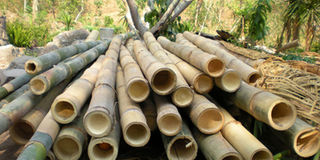There is money in bamboo products

Bamboo is a giant woody grass which is grown mostly in the tropics. There are many products that can be made out of Bamboo including: shampoo, cosmetics, bamboo flooring and beehives among others. FILE PHOTO
What you need to know:
Bamboo could be the next big cash crop in the country considering its uses. Dorothy Nakaweesi shares how you can diversify your income from making its products.
Bamboo is that cash crop we probably haven’t thought about in detail. Bamboo, a giant woody grass which is grown mostly in the tropics, and is used as a cane or poles to support their banana plants from falling.
But did you know that you can earn big from processing the hollow jointed stem of the bamboo plant into different products?
It is believed that bamboos are some of the fastest-growing plants in the world, due to a unique rhizome-dependent system.
Products
There are quite a number of products that can be made out of Bamboo including umbrellas. Other products are shampoo, cosmetics, deodorant, hard alcohol, beer, bamboo flooring, beehives, record player needles and bamboo roofing.
More so, bamboo can be used as a building material in scaffolding, bridges and houses because of its high compressive strength compared to wood, brick or concrete and a tensile strength that rivals steel.
Ladies, if you check in your closet, you probably have some clothing that was made with bamboo. Bamboo fibres can be mixed with other materials to make clothes.
Capital investment
To start this kind of business, Uganda Investment Authority (UIA) says those who want to do large scale can aim at producing 520 units per month, translating into 6,240 units annually. To produce these units, you need an initial capital investment worth $1,465 (Shs5.3 million).
This means annually, the revenue potential is premised on $54,600 (Shs199 million). The project has an estimated net profit of $14,594 (Shs53 million) and a payback period of two years and seven months.
“Already, the number of Ugandans growing bamboo is increasing so you will be assured of the steady supplies,” UIA records show.
Mr Andrew Ndawula Kalema, one of the Ugandans with passion in bamboo production and value addition, says investing in this kind of project is one way to reduce unemployment and poverty in the country.
He shares that one can invest in only one pole of bamboo which costs between Shs3,000 and Shs5,000 as your starting capital.
“From a single pole, you can make 30 pairs of ear-rings, if each is sold at Shs5,000 you will smile all the way to the bank with Shs150, 000,” he shares.
He adds that with bamboo jewellery, the market is big ranging from tourists who like it to local people who have embraced it.
Mr Kalema who has planted different species of bamboo seedlings alone boasts of a steady annual income of between Shs30 million and Shs50 million.
“There is a bamboo species that I have planted which is most liked by planters who use it to plant herbs and climbing flowers hanged on balconies. One pole of this species costs Shs40,000,” he says.
Production
According to UIA, the equipment required includes: knives, fixtures and hand tools. The manufacturing process starts with splitting bamboo into thin wafers to suit the variegated needs of the end product.
This is followed by manually knitting the split wafers into products designed to cater for the needs of the customer.
Bamboo shoots can be eaten as food, poles for agriculture and structures, panels and composite materials for houses and buildings, versatile household products (furniture, kitchen utensils).
Other products which can be made out of bamboo include pulp and paper, fibre for textiles, medicinal and bio-chemical products (including bio-plastics and bio-fuels) and charcoal for cooking and heating.
Trials
Just like any other business, bamboo business is facing lack of raw materials because the product is not widely grown in the country and there a few people who grow it on a large scale.
“But this is being worked on in Uganda and the region through the project called -the Dutch-Sino-East Africa Bamboo Development programme- implemented to support poverty reduction, sustainable development, climate change action,” Mr Kalema says.
Mr Kalema says the website of International Bamboo and Rattan Organisation, a multilateral development organisation of 42 states including Uganda for the promotion of bamboo and rattan, shows that bamboo has a higher compressive strength than wood, brick, or concrete.
Uganda has an estimated 40,000 – 50,000 hectares of bamboo. The project covers Uganda, Kenya and Ethiopia which have sub-Saharan Africa’s largest natural bamboo forests and accounting for 3 to 4 per cent of the world’s total known bamboo coverage.




